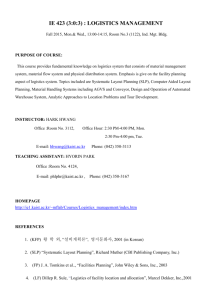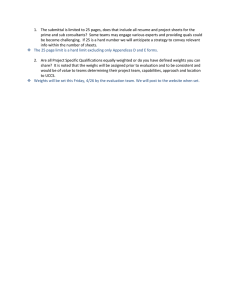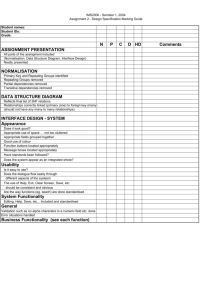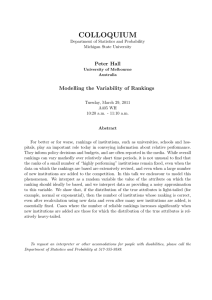“How Robust is the Foreign Policy/Kearney Index of Globalisation?” Ben Lockwood
advertisement
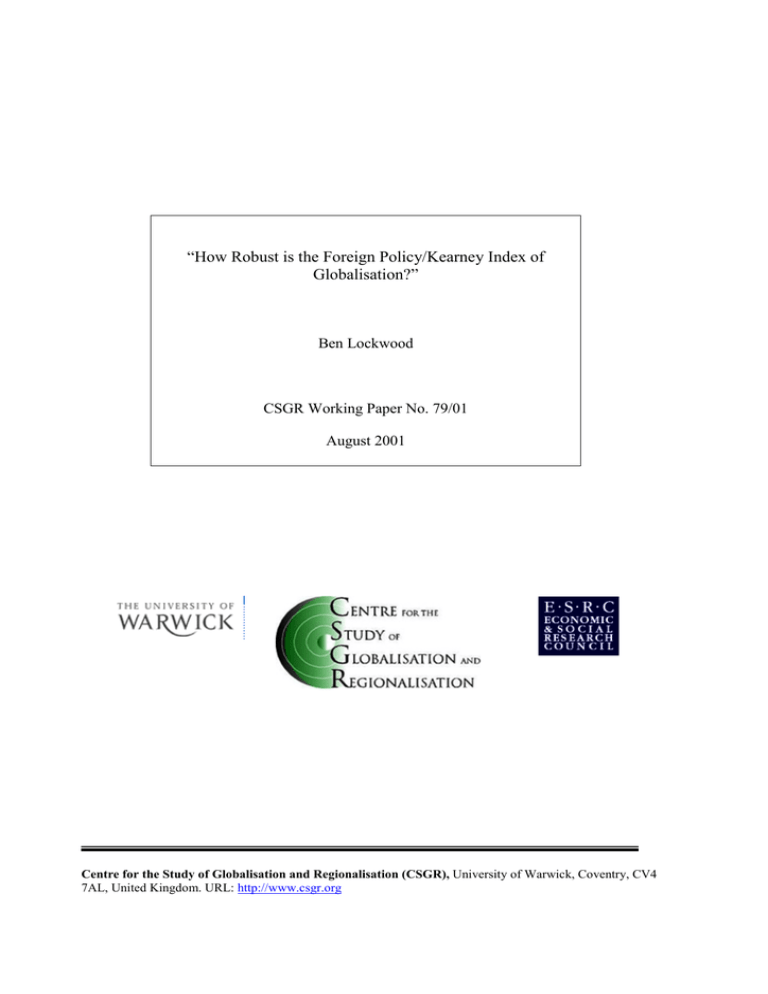
“How Robust is the Foreign Policy/Kearney Index of Globalisation?” Ben Lockwood CSGR Working Paper No. 79/01 August 2001 Centre for the Study of Globalisation and Regionalisation (CSGR), University of Warwick, Coventry, CV4 7AL, United Kingdom. URL: http://www.csgr.org 2 How Robust is the Foreign Policy/Kearney Index of Globalisation? Ben Lockwood1 CSGR, University of Warwick2 CSGR Working Paper No. 79/01 First version: August 2001 This version: November 2001 Abstract We argue that the Kearney/Foreign Policy (KFP) index of globalisation is constructed by making some problematic assumptions about the measurement, normalisation and weighting of the variables included in the index. We propose alternative measurement, normalisation and weighting rules, and using these rules, recalculate the ranking of the fifty countries, using the original KFP data. Specifically, we use, in various combinations: (i) variables “adjusted” for geographical characteristics of countries; (ii) statistically optimal weights obtained by principal components analysis; (iii) a normalisation rule that treats different years of observations separately. We find that the country rankings change significantly when adjusted variables are used, indicating that the original KFP index is partially measuring geographical differences between countries. Keywords: globalisation, measurement, indices, principal components. Address for correspondence: Professor Ben Lockwood Centre for the Study of Globalisation and Regionalisation University of Warwick, Coventry CV4 7AL, UK. Email: b.lockwood@warwick.ac.uk 1 I would like to thank Tanweer Akram and Jay Scheerer of A.T.Kearney for their very generous help in providing me with information about the construction of the index. 3 1. Introduction The Kearney/Foreign Policy (KFP) index of globalisation has had a major impact since an article reporting on the index was published in Foreign Policy earlier this year3. For example, a search on Google, the internet search engine, gives around 115 citations of the index, by newspapers such as USA Today and the Christian Science Monitor, national governments, and think-tanks. KFP claim that their index is “a unique and powerful tool for understanding the forces shaping today’s world”. The method for constructing their index is based on that used to construct the well-known UNDP Human Development Index (UNDP(1998)). First, a judgement is made about the “relevant variables” that should enter the index. Second, quantitative measures of these variables are made – here, data constraints are important. Third, these quantitative measures are normalised, to deal with the problem that different variable are typically measured in different units and therefore may yield wildly different numerical values. For example, in the Human Development Index, two of the variables are life expectancy (measured in years) and per capita GDP (measured in dollars), so before normalisation, the second variable has an average of roughly 100 times the first. Fourth, a weighted sum of the normalised variables is calculated, which gives a numerical score for each country. This note focuses on stages two, three and four of the index construction (stage one is more a question of subjective judgement based on theory, plus data availability). At stage two, KFP essentially use outcome-based measures of the different dimensions of globalisation, rather than policy-based measures4. For example, to measure openness to trade, they use the measure of the value of imports and exports as a percentage of GDP. A well-known problem with trade openness, thus defined, is that it depends on country characteristics, such as population size, land area, and geographical location, as well as on the underlying trade policy of the country. Following Pritchett(1996), we suggest a regression-based method for controlling for the geographical characteristics of countries, and we apply this method uniformly to all eleven variables used in the KFP index. This gives us structurally adjusted 3 A.T.Kearney, Inc. Global Policy Group & Foreign Policy Magazine, “Measuring Globalisation”, Foreign Policy, 122, 56-65. In what follows, KFP is understood to refer to A.T.Kearney, Inc. Global Policy Group & Foreign Policy Magazine, who jointly produced the index. 4 . There are eleven separate variables used in the KFP index. 4 versions of the KFP variables, which, we would argue, are better measures of what they are intended to measure than the original unadjusted variables. A second problem with the KFP method is that at stage three, they assume arbitrarily chosen weights on the eleven variables (described in more detail in Section 2 below): basically, some variables are double-weighted, and most single weighted. One possible justification for a priori weights is that they have some normative significance. For example, in the Human Development Index, life expectancy, educational attainment, and income per capita are weighted equally, perhaps reflecting a judgement than all three variables are equally important in defining “human development”. This argument is less compelling in the case of globalisation, as it is a less normative concept than that of human development. We argue in this paper that another (and possibly preferable) way of weighting the variables is to take a statistical approach, based on principal components: roughly speaking, this involves choosing weights that maximise the informativeness of the overall index, as measured by the variance of the index across countries at a point in time. Finally, KFP adopt a particular way of normalising the individual variables, which they call panel normalisation. This paper argues that this normalisation rule has the property that a change in some variable included in the index in one year can change the ranking of countries (according to the index) in another year. Given that a major use of the index is to construct country rankings, or a country “league table” in a given year, this property is clearly undesirable. We propose an alternative normalisation procedure, which we call annual normalisation, which avoids this problem. We then recalculate the KFP globalisation index under various different combinations of these alternative procedures for measurement, normalisation, and weighting of variables. This gives us a number of possible “alternative” indices of globalisation based on the same basic choice of variables as the KFP index. We then ask how much the country rankings change when one of these alternative indices is used to rank countries. Our main finding is that the changes in the rankings are relatively insignificant, except when the structurally unadjusted data is replaced by adjusted data. In this case, 94% of countries change position in the rankings, and over a third change position by 15 ranks or more (e.g. China rises from 48th out 5 of 50 in the original KFP ranking to 17th out of 50). The conclusion is that the position of many countries in the KFP ranking may depend critically on their geographical characteristics, as much as on their policy stance towards globalisation. That is, geography matters. 2. A Review of the Kearney/Foreign Policy Index The KFP index is based on 11 variables, itemised as follows: Table 1: Variables in the KFP Index Category Globalisation in goods and services Variable Name Trade Convergence Financial globalisation Income FDI Portfolio Globalisation of personal contact Tourism Telephone Internet connectivity Transfer payments Internet users Internet hosts Secure servers Variable Definition Imports plus exports as % of GDP The ratio of nominal to PPP GDP Credits plus debits as % of GDP Inward plus outward FDI as % of GDP Inward plus outward portfolio investment as % of GDP Inward plus outward tourists as % of population Minutes of inward plus outward international telephone traffic per head Credits and debits as % of GDP Internet users as % of population Internet hosts per million inhabitants Secure servers per million inhabitants Weight 1 1 1 2 2 1 2 1 2/3 2/3 2/3 As Table 1 indicates, these variables5 are chosen to measure four underlying dimensions or categories of globalisation, and are measured for 50 countries over the four years 1995-98. They are normalised by a procedure called panel normalisation. To illustrate, suppose the variable is trade. First, the minimum and maximum values of this variable over the years 1995-98, and over all countries, are found. For the case of the trade variable, it turns out that the maximum is 339%, for Singapore in 1995, and the minimum is 15%, for Brazil in 1996. 5 The variables are publicly available in pdf format at: http://www.atkearney.com/main.taf?site=1&a=5&b=4&c=1&d=18. 6 Then, if the trade variable for some country (say the UK) in some year is x%, then the panel normalised value of x is y = (x – 15)/(339-15) Note that with this normalisation, all values of y lie between zero and one. Finally, the weighting of the variables in the KFP index is as reported in Table 1. Note that internet connectivity is treated effectively as a single variable with double weight: then, all variables have either single or double weight. 3. A Critique (a) Controlling for Geographical Characteristics Broadly speaking, the variables used in the KFP index to measure different dimensions of globalisation measure outcomes, rather than policy. For example, the variable they use to measure openness to trade is the value of total trade (imports plus exports) as a percentage of GDP. A well-known problem with this measure of trade openness for a given country is that it depends not only on underlying trade policy (i.e. tariff and non-tariff barriers to trade imposed by the country in question) , but also on the geographical and economic characteristics of a country. Other things equal, countries with large populations and diversified economies will trade less (as a proportion of GNP) than small countries. For example, both the Netherlands and the US are highly open to trade in the sense that they have low tariffs and non-tariff barriers. However, in 1998, the KFP trade openness scores for the Netherlands and the US were 111% and 24% respectively. But is the Netherlands really over four times more open to trade flows than the US? The most radical way of dealing with this problem is to try to measure the underlying policies directly. In the case of trade, this is feasible, as data is available on average tariffs and nontariff barriers (e.g. from the World Bank), but for many aspects of globalisation, this is simply not possible, as the policies determining the outcomes are multi-dimensional and not easily measured on some quantitative scale. How, for example, would one measure national policies towards internet connectivity? An alternative approach, which has been used in measuring trade openness (e.g. Pritchett(1996)), is to correct the outcome measure of trade openness for relevant country 7 characteristics. This is done by regressing the trade openness measure across countries in the sample on a number of country characteristics that are thought (a) to be exogenous to trade, and (b) relevant in determining trade as a percentage of GNP. The resulting residuals from the regression can then be interpreted as a “corrected” or “adjusted” measure of trade openness6. Pritchett(1996) calls this residual “structure-adjusted trade intensity” Here, we apply this method of structural adjustment to all the variables7 used in the KFP index. Our choice of relevant country characteristics were: population in 1998, the natural log of land area, and dummy variables recording whether the country was either landlocked or in the tropics. The first two variables were used by Pritchett(1996). A landlocked dummy is included as countries without seaports face higher costs of international trade, and this may well affect foreign direct investment. Indeed, Sachs(2001) finds that distance from the seacoast is negatively related to per capita GDP. The motivation for inclusion of a tropics dummy was the recent work of Jeffrey Sachs, who argues persuasively8 that location is a tropical climatic zone is a very important determinant of economic underdevelopment, and we would expect the level of globalisation to be related to the latter. Finally, we do not include the usual measure of economic development, GDP per capita, although its inclusion would undoubtedly increase the explanatory power of our regressions. The reason is the following. In our view, what the KFP index is ultimately trying to measure is to what extent the past and present policy choices of a country have led it to integrate with the world economy (and society). These policy choices (given geographical characteristics) also determine its level of economic development (as measured by GDP per capita). So, “stripping out” the effects of economic development from the various measures of globalisation would in fact be removing valuable information from these measures. The regression results are described below. 6 The explanatory variables used by Pritchett were: population, the log of land area, a measure of transport costs, GDP per capita, GDP per capita squared, and an oil dummy. 7 The secure server variable in Table 1 was constructed from data owned by Netcraft.com, and A.T.Kearney could not make the data available to me. So, the regressions were run for the ten remaining variables. This data problem obviously also necessitates a change in the construction of the Index, as described in Section 3 below. 8 “Perhaps the strongest empirical relationship in the wealth and poverty of nations is the one between ecological zones and per capita income. Economies in tropical ecozones are nearly everywhere poor, while those in temperate zones are generally rich.” Sachs(2001). 8 Table 2: Regressions to Adjust for Country Characteristics Variable Name Trade Convergence Income FDI Portfolio Tourism Telephone Transfer payments Internet users Internet hosts Population 0.012 (0.453) -0.0011 (-0.110) -0.00009 (-0.0012) -0.000828 (-0.232) -0.0032 (-0.758) -0.0268 . (-0.691) 0.168 (0.174) -0.00055 (-0.403) -0.0062 (-0.990) -14.823 (-0.862) Area -16.56 (-5.144) -1.2678 (-1.022) -0.9779 (-1.000) -0.784 (-1.810) -0.977 (-1.914) -22.784 (-4.837) -52.629 (-4.493) -0.613 (3.699) -0.8493 (-1.110) -43.184 (0.021) Landlocked 9.397 (0.461) -8.636 (-1.099) 0.8070 (0.130) -1.4369 (-0.524) -1.52 (-0.473) 195.69 (6.559) 11.555 (0.156) -0.50 (-0.476) -2.621 (-0.541) -3236.184 (-0.245) Tropical 30.138 (2.492) -6.637 (-1.424) -2.2998 (3.67) -1.348 (-0.828) -4.889 (-2.553) -45.554 (-2.574) -41.346 (-0.940) -0.715 (-1.148) -6.652 (-2.315) -18540.91 (-2.362) R2 0.4680 p-value* 0.0000 0.0735 0.4764 -0.0450 0.7560 0.0190 0.3087 0.1556 0.0213 0.7038 0.0000 0.3213 0.0002 0.2436 0.0022 0.0852 0.0912 0.0427 0.2050 Population in millions (1998 figures), area in thousand square km, landlocked = 1 if country has no sea coast, tropical = 1 if is mostly in a tropical ecozone (data from World Bank and the CIA). T-statistics in brackets. * p-value for F-statistic measuring joint significance of explanatory variables. The constant term is not reported. Some comments can be made about these results. First, in many equations, the goodness of fit (R2) is quite high for cross-country regressions of this type, bearing in mind that we are using a common and small set of explanatory variables in every regression, and furthermore this set does not include GNP per capita. For example, the R2 in the trade equation is as high as the R2 of Pritchett’s (1996) trade equation, which includes terms in GDP per capita, but excludes geography dummies. Second, where they are significant, variables have mostly have plausible signs. For example, the coefficient on the log of country area is always negative, indicating that the larger the country, the lower the measure of globalisation, whenever area has a significant effect9. Second, the tropical dummy is often significant, and when it is, it is always negative, except in the case of trade, where is significant, large, and positive (a tropical country, other things equal, is 30 percentage points more open than a temperate one). The work of Sachs provides some explanation for this: tropical countries tend to be less economically developed, and 9 Population is always insignificant, probably because it is highly correlated with area. 9 heavily reliant on exports of primary commodities. However, the landlock dummy does not have any effect on trade, but only affects tourism (strongly positively). This is explained by the fact that the only landlocked countries in the sample are small, higher-income, European countries (Austria, Czechoslovakia, Hungary, Switzerland). Finally, in what follows, the structurally adjusted variables are simply the residuals from these regressions e.g. structurally adjusted trade openness is the residual from the first regression. (b) Alternative Normalisation Rules The main advantage of panel normalisation, used by KFP, is that it allows comparison of a given variable, and therefore the overall globalisation index, for a given country in two different years. However, in the Foreign Policy article, KFP present their globalisation index mainly as means of ranking different countries in a given year. Moreover, this “league table” aspect of their work has been the one that has caught the attention of most commentators. However, if the objective is to rank different countries in a given year, it can be argued that panel normalisation is not the appropriate normalisation rule. The problem is the following. With panel normalisation, a change in the value of some variable (say, trade openness) in one year for some country can clearly change the value of this variable in other years. For example, suppose Brazil’s trade openness variable rose from 15% to 20% in 1996; from the above formula in Section 2, this would change the value of trade openness for the UK in (say) 1998. In turn, this can change the overall ranking of the countries according to the index, even in year(s) when no change in the data took place! To illustrate this point, consider the following example, which is a very simplified version of the UN’s Human Development Index, with just two variables, life expectancy and income10 The life expectancies (in years) for two countries are given below: Country A Country B 2000 75 70 2001 76 80 Then, the panel normalised life expectancies for Country A are 10 0.5 = (75-70)/(80-70), 0.6 = (76-70)/(80-70) in years 2000, 2001 respectively, and the panel normalised life expectancies for Country B are 0,1 for the same two years. Now suppose that the overall index is made up of lifeexpectancy and GDP per capita, equally weighted, and suppose that on this second variable, the panel normalised GDP per capita in 2001 is 1.0 for country A, and 0.7 for country B. So, the overall scores on the index in 2001 are: Country A: 0.6+1.0 = 1.6 Country B: 1.0 + 0.7 = 1.7 So, we conclude that in the year 2001, country B ranks higher on the development index. Now suppose that life expectancy in country B were 60 years, rather than 70. Then, it is easy to calculate that the panel normalised life expectancies for Countries A, B in the year 2001 are (76-60)/(80-60) = 0.8, and 1.0 respectively. But then with this change, country B’s score on the overall development index in 2001 is unchanged, whereas A’s score rises to 0.8+1.0 = 1.8. So, country A is now most highly ranked on the overall development index in 2001! Note this occurs even though neither life expectancy nor GDP per capita have changed for either country in 2001. This example illustrates that, generally, panel normalisation induces a non-separability between years in the sample: a change in the data in one year can induce a change in the ranking in another year. An obvious alternative ranking rule which avoids this non-separability is just to normalise the relevant variable to lie between zero and one in any given year. To illustrate, take the trade openness variable again. In 1995, the maximum value of this variable was 339%, for Singapore, and the minimum, 17% for Brazil. Also, the trade variable for the UK was 58%, so the normalised value for the UK in 1995 is (58-17)/(339-17) = 0.127. Again, in 1996, maximum value was 327%, the minimum was 15%, and for the UK it was 60%. So the 10 We use this example because the KFP index involves too many variables to make the point cleanly. 11 normalised value for the UK in 1996 is (60-15)/(327-15) = 0.144. We will call this method annual normalisation. (c) Alternative Weights The weights chosen by KFP to aggregate the variables into a single index are arbitrary in the sense that they are not justified either by a priori reasoning or statistically. As argued in the Introduction, a plausible alternative is to use statistically optimal weights which maximise the informativeness of the index, as measured by the variance of the index across countries at a point in time. Here, we calculate the optimal weights for the 1998 data. These can, in principle, be calculated for both possible normalisations of the data11, using both the raw data and the structurally adjusted data, having controlled for country characteristics. This gives us four different data sets for which to calcualte optimal weights. However, to calculate panelnormalised structurally adjusted data requires the regressions of Section 3(a) to be run separately for all four years in the KFP sample. So, without much loss of generality, we only calculate the structurally adjusted data for 1998, which means that these data can only be normalised according to the annual method. This gives us three different data sets for which to calculate optimal weights. Table 2 below shows the optimal weights in all three cases, along with the weights used by KFP. All weights have been normalised so that they add up to one, in order to make easy comparisons. Table 3: Optimal Weights Variable Name Trade Convergence 11 KFP Weights 0.077 0.077 Optimal weights (panel normalisation) 0.063 0.009 Optimal weights (annual normalisation) Optimal weights (annual normalisation, SA variables) 0.071 0.034 0.088 0.024 There is a technical issue here, namely that calculation of optimal weights via principal components usually involves a normalisation in itself i.e. transforming each variable so that it has mean zero, and standard deviation of unity (Mardia, Kent and Bibby(1994)), to deal with non-normalised data. We proceed by calculating the optimal weights without this normalisation: technically, we calculate the principal eigenvector of the covariance matrix of the data, rather than the correlation matrix. 12 0.077 0.079 0.085 0.097 0.154 0.122 0.109 0.120 0.154 0.114 0.105 0.085 0.077 0.168 0.156 0.184 0.154 0.135 0.125 0.172 0.077 0.022 0.046 -0.069 0.077 0.163 0.151 0.166 0.077 0.124 0.118 0.133 Note: In each case, the vector of optimal weights is the normalised eigenvector of the maximal eigenvalue of the covariance matrix of the variables for the year 1998, calculated using Stata. Weights may be negative. Income FDI Portfolio Tourism Telephone Transfer payments Internet users Internet hosts Note that there is not much correspondence between the KFP and optimal weights. Two notable features are that the optimal weights on the internet variables are much higher than the KFP weights, and the reverse is true for the convergence variable. 3. Recalculating Country Rankings In their foreign policy article, KFP present various cross-country comparisons based on country rankings in 1998 generated by their index. A complete ranking of all 50 countries is available from their website (at the address given in footnote 4). In this section, we recalculate the country rankings for 1998., using the different possible approaches to variable measurement, normalisation, and weighting discussed above. Given the above discussion, one could recalculate the KFP index in three ways: (i) use the structurally adjusted variables after correcting for geography; (ii) use optimal weights, rather than a priori weights; (iii) use annual, rather than panel, normalisation;. Bearing in mind that we have not constructed panel-normalised residual variables, there are then five possible recalculations12. The five country re-rankings are reported in Table A1 at the end of the paper, along with the country rankings under the original KFP assumptions13. Below, we report two measures that indicate how well “correlated” the alternative re-rankings are with the country rankings under the original KFP assumptions. 12 As there are eight possible combinations of these three binary alternatives, eight different indices can be calculated in total. One of these (structurally unadjusted variables, KFP weights, panel normalisation) is obviously the original index (subject to the qualification expressed in footnote 12 below), so there are seven different possible recalculations. Two of these are ruled out by the fact that we have not constructed panelnormalised structurally adjusted data. 13 As noted above, the secure server variable in Table 1 was constructed from data owned by Netcraft.com, and A.T.Kearney could not make the data available to me. So, I have modified their original index slightly by taking the remaining two variables (with equal weights of 0.5 each) to measure internet connectivity. So, the country rankings under the original KFP assumptions (the first column of Table A1) are slightly different to the actual KFP country rankings for 1998, as reported at their website. 13 Table 4: Measures of Association Between Rankings No of countries whose rank changes (relative to rank under the KFP assumptions) Spearman rank correlation* Re-ranking 1: Panel normalisation, optimal weights Re-ranking 2: Annual normalisation, KFP weights Re-ranking 3: Annual normalisation, optimal weights Re-ranking 4: SA variables, Annual normalisatio n, KFP weights Re-ranking 5: SA variables, Annual normalisation, optimal weights 43 (86%) 35 (70%) 34 (68%) 47 (94%) 47 (94%) 0.9753 0.9839 0.9846 0.5582 0.5463 *This measures the correlation between the country rankings under the original KFP assumptions, and under the new assumptions. In every case, the null hypothesis that the two rankings are independent can be rejected at the 1% level. The first row of Table 4 simply records how many countries change their position when we move from the original ranking to the re-ranking. For example, when we move from the original ranking to the first re-ranking (by the index with panel normalisation, but optimal weights) 43 of the 50 countries change their positions. However, it is also interesting to ask how large the changes in position are. The magnitude of the changes is illustrated in Figure 1, which gives histograms of the absolute size of the changes in rankings across countries, for each of the five possible re-rankings. This illustrates an interesting pattern. For changes that do not involve a move to structurally adjusted variables, the changes in the ranking experienced by countries are relatively small: virtually no country moves up or down by more than 10 positions. However, when structurally adjusted variables are used, the size of the re-ranking is much larger. As Figure 1 shows, if the ranking is based on structurally adjusted variables using optimal weights, 16 countries experience a change in position of 15 places or more, and if the ranking is based on structurally adjusted variables using the KFP weights, 18 countries experience a change in position of 15 places or more. These large changes are generated in part by countries with large land area and population, or tropical location, moving up the league table. This is because these characteristics, other things equal, lead a country to be less globalised, so once these characteristics are controlled for, the country with these characteristics will do better in the rankings. A clear example is 14 China, which rises from 48th in the original KFP ranking, to 16th in both rankings based on structurally adjusted data. By the same argument, those countries with small land area and population, or temperate location, will move down. A clear example is South Korea, which falls from 32nd to 50th in the ranking is based on structurally adjusted variables using the KFP weights Finally, Table 4 reports values of Spearman’s rank correlation coefficient which measure the correlation between the different re-rankings, and the original KFP ranking. As Table 4 indicates, in the first three cases, the coefficient is very high, and is considerably lower for the indices calculated from the structurally adjusted data. This suggests that of the three methodological changes to the construction of the globalisation index suggested in this paper, controlling for country characteristics is by some margin, the most important in terms of the change in the outcome. Note, however, that in each case, the null hypothesis that the new ranking and the original KFP ranking are statistically independent can easily be rejected at even the 1% significance level. Note the apparent discrepancy between the rank correlation coefficients, which are quite high, and the fact that a large majority of countries change position in the ranking in each case. These two facts can be reconciled by noting that (especially when structurally unadjusted, or “raw” variables are used) while many countries change position in the rankings, very few countries change position by very much. For example, when changing to re-ranking 1, few countries move more than three or four places. As Spearman’s rank correlation coefficient puts a large weight on large changes, and a small weight on small changes, this explains the high value of the coefficient, in spite of the fact that many changes are observed. One way of presenting these results is in terms of “ranges” on the rankings of countries. Suppose that we regard both unadjusted and adjusted data, the KFP and the optimal weights, and the panel and annual normalisations, each as “equally plausible”. One can then ask what the range of possible rankings of a particular country is under the six different rankings. The range then gives some indication of the uncertainty surrounding that country’s true position in the global league table. Some illustrative calculations are reported below. 15 Table 4: Some Ranges UK Italy US Japan Range 9-12 6-27 2-14 26-48 So, we see that the UK and US ranks are definitely more precisely determined than those of Italy and Japan. 4. Conclusions This paper has argued that there are problems with the measurement, weighting, and normalisation rules used to construct the KFP index of globalisation, even if one accepts the list of variables that should be included in the index. Alternative measurement, weighting and normalisation rules have been proposed, and it is shown that re-calculating country rankings according to these alternative rules leads to many countries changing places in the rankings, some quite significantly. These same criticisms made here of the KFP index also apply in principle to other indices used to rank countries, such as the Human Development Index, and so a possible future project would be to apply the techniques developed in this paper to recalculate other indices. References A.T.Kearney, Inc. Global Policy Group & Foreign Policy Magazine (2001), “Measuring Globalisation”, Foreign Policy, 122, 56-65 Mardia, K.V., J.Kent, and J.Bibby (1994), Multivariate Analysis, Academic Press Pritchett, L.,(1996), “Measuring outward orientation in LDCs: can it be done?” Journal of Development Economics, 49, 307-335 Sachs,J.(2001), “Tropical Underdevelopment”, NBER Working Paper No. W8119 UNDP(1998), Human Development Report 1998, Oxford University Press Table A1: Results of Different Normalisation and Weighting methods Ranking 1 2 3 4 5 6 7 8 9 10 11 12 13 14 15 16 17 18 19 20 21 22 23 24 25 26 27 28 pnKFP* Singapore Netherlands Sweden Finland Switzerland Ireland Austria Norway United Kingdom Denmark Canada United States Italy Germany Portugal France Hungary Spain Malaysia Czech Republic Israel New Zealand Morocco Australia Greece Poland Chile South Africa pnopt Singapore Sweden Finland Switzerland Netherlands Austria Ireland Norway Denmark Canada United Kingdom United States Czech Republic Hungary Germany France New Zealand Portugal Spain Italy Malaysia Australia Israel Poland Greece Morocco Japan Chile anKFP Singapore Netherlands Ireland Sweden Switzerland Austria Italy Finland United Kingdom Norway Denmark Portugal Canada United States Hungary France Israel Germany Malaysia Spain Czech Republic Greece New Zealand Poland Sri Lanka Australia Tunisia South Africa anopt Singapore Sweden Finland Switzerland Netherlands Ireland Austria United States Norway Denmark Canada United Kingdom Hungary Czech Republic Germany Portugal France Italy Malaysia New Zealand Spain Israel Australia Greece Poland Japan Tunisia Chile ansaKFP Sweden United States Canada Singapore Finland Netherlands Ireland Norway Malaysia Switzerland United Kingdom Austria Australia brazil Italy France China Spain Germany Indonesia Mexico Russian Federation Denmark Nigeria Thailand Portugal Peru Venezuela, RB ansaopt Singapore Canada Sweden United States Finland Ireland Norway Netherlands Switzerland Malaysia Australia Austria United Kingdom brazil France Denmark China Germany Mexico Russian Federation Indonesia Spain New Zealand Thailand Venezuela, RB Peru Italy Poland 17 29 30 31 32 33 34 35 36 37 38 39 40 41 42 43 44 45 46 47 48 49 50 Japan Tunisia Thailand Korea, Rep. Sri Lanka Ukraine Philippines Venezuela, RB Egypt, Arab Rep. Turkey Indonesia Argentina Mexico Nigeria Peru brazil Russian Federation Colombia Kenya China India Iran South Africa Korea, Rep. Tunisia Thailand Ukraine Argentina Venezuela, RB Mexico Philippines Indonesia Turkey Peru Russian Federation brazil Sri Lanka Colombia Nigeria China Egypt, Arab Rep. Kenya India Iran Morocco Korea, Rep. Egypt, Arab Rep. Chile Japan Ukraine Turkey Kenya Thailand Philippines Indonesia Nigeria Mexico Argentina Venezuela, RB Peru Russian Federation Colombia brazil China India Iran Korea, Rep. South Africa Sri Lanka Thailand Morocco Ukraine Philippines Egypt, Arab Rep. Mexico Turkey Indonesia Venezuela, RB Argentina Nigeria Peru Kenya Russian Federation brazil Colombia China India Iran Colombia New Zealand India Kenya Hungary Philippines South Africa Argentina Chile Poland Czech Republic Egypt, Arab Rep. Greece Ukraine Turkey Sri Lanka Iran Morocco Israel Japan Tunisia Korea, Rep. Colombia Argentina Nigeria Philippines Czech Republic India South Africa Portugal Chile Japan Kenya Ukraine Iran Hungary Greece Turkey Tunisia Egypt, Arab Rep. Israel Morocco Korea, Rep. Sri Lanka *Key: pn = panel normalisation, an = annual normalisation, sa= structurally adjusted variables, KFP = KFP weights, opt = optimal weights. So, for example, pnKFP denotes: panel normalised data, not structurally adjusted, aggregated using KFP weights, etc. 18 Degree of Change in the Ranking 40 35 30 pnopt 25 anKFP anopt 20 ansaKFP ansaopt 15 10 5 0 0-2 3-4 5-6 7-8 9-10 11-12 13-14 15-20 >20
